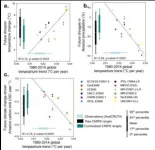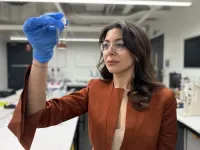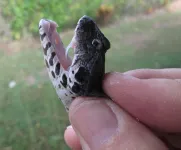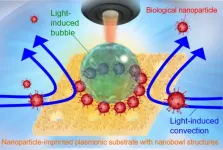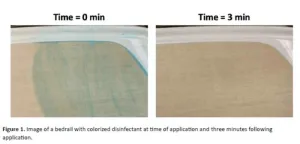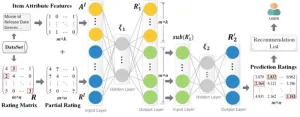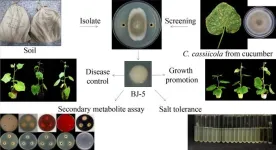Global warming leads to drier and hotter Amazon: reducing uncertainty in future rainforest carbon loss
A new study narrows the uncertainty in future Amazon carbon cycle predictions and reveals that future climate change may reduce the Amazon rainforest’s ability to act as a carbon sink by making it drier and hotter
2024-09-19
(Press-News.org)
The Amazon, often called the "lungs of the planet", is the world’s largest tropical forest, playing a crucial role in the global climate system due to its vast carbon storage. While it is typically warm and humid all year round, continued climate change poses the threat of more frequent and severe droughts and heat extremes. A new study, published in Nature Communications delves into future projections of the Amazon carbon cycle, focusing specifically on the impacts driven by climate change.
Scientists use the latest generation of Earth system models from the Coupled Model Intercomparison Project which contributed to the IPCC's Sixth Assessment Report. In the study framework, the climate change impacts are isolated from other factors such as land-use changes, including deforestation, and the CO2 fertilization effect on photosynthesis. An advanced technique known as Emergent Constraints that allows reducing uncertainties in future predictions using past observations is employed.
The study shows that future climate change may lead to hotter and drier conditions in the Amazon rainforest that reduces the Amazon carbon sink, in other words carbon dioxide absorption by plants. The lead author Dr. Irina Melnikova, a research associate at NIES, said that “this happens because global warming is accompanied by a phenomenon known as polar amplification—greater warming in polar regions compared to others”. It causes the intertropical convergence zone, a tropical rain belt crucial for the Amazon's climate, to shift northward. Such a shift would make Amazon drier and warmer, reducing the rainforest's ability to absorb carbon dioxide through photosynthesis while increasing carbon dioxide emissions through plants and soil respiration. Combined with the increased risk of droughts and fires in the hotter and drier conditions, this results in a net loss of carbon from the rainforest.
The new study also reveals that Earth system models, which estimate higher past global temperature trends, are more likely to predict a hotter, drier Amazon under a high-emission scenario compared to other models. The study concludes that the models that can reproduce past observational global warming trends have higher reliability in predicting the future Amazon climate change-driven carbon sink. "By refining our projections with emergent constraints, we can provide more accurate predictions of future climate impacts, which are essential for informed policymaking," stated Melnikova.
This research successfully reduces uncertainties in predicting the Amazon's response to climate change, enhancing our understanding and highlighting the critical role of accurate climate models in shaping future conservation strategies and global climate policies. The findings also reveal the potential for further warming to trigger large-scale atmospheric circulation changes, leading to a drier and hotter Amazon climate and increased carbon emissions from the rainforest. The authors caution that “While our study provides a more nuanced understanding of the Amazon's future, it also underscores the urgency of mitigating climate change to prevent the worst-case scenarios. The Amazon's fate is not just a regional concern but a global one.”
END
ELSE PRESS RELEASES FROM THIS DATE:
2024-09-19
A new way of making ammonia by harnessing the unique power of liquid metal could lead to significant cuts in carbon emissions caused by production of the widely-used chemical.
Ammonia is used in fertiliser to grow much of our food, but also plays a role in clean energy as a carrier to safely transport hydrogen.
The global production of ammonia, however, comes at a high environmental cost: it consumes over 2% of global energy and produces up to 2% of global carbon emissions.
RMIT Research Fellow and study ...
2024-09-19
Researchers have uncovered a fascinating mechanism behind the reduction and asymmetry of emu wing bones. The wings not only show significant shortening, but the skeletal elements also fuse asymmetrically, a phenomenon traced back to the absence of muscle formation in the distal regions of the wings. During development, this lack of muscle leads to insufficient mechanical stress, which is crucial for proper bone formation. The team identified muscle progenitor cells with a unique dual identity, combining characteristics of both somite1-derived myogenic and lateral plate mesoderm2 cells. These ...
2024-09-19
Only about ten percent of the world’s roughly 4,000 snake species have venom strong enough to seriously hurt a human, but that’s enough for snake bites to be an important public health concern. To help better understand how snakes make their venom and how venoms differ from one species to another, researchers developed a new way to zero in on the genes that snakes use in venom production. Their work was published in the journal Molecular Ecology Resources.
“We’ve developed a tool that can tell us which venom-producing genes are present across an entire snake family in one fell swoop,” says Sara Ruane, the Assistant Curator of Herpetology in the ...
2024-09-19
· Daily homework of up to 15 minutes most effective for maths achievement
· Homework assigned three to four times a week benefits science performance
· Short duration homework just as effective as longer assignments
Researchers at Maynooth University’s Hamilton Institute and Department of Mathematics and Statistics in Ireland have unveiled significant findings on the role of homework in student achievement. The research, led by Prof Andrew Parnell, Nathan McJames and Prof Ann O’Shea, used a new AI model to analyse data from the Trends in International Mathematics and Science ...
2024-09-19
A new paper in Oxford Open Climate Change, published by Oxford University Press, uncovers evidence suggesting that, contrary to expectations, most U.S. cities are not doing too badly in avoiding development in areas prone to flooding, and those that are effective appear to be applying existing tools and strategies well, rather than doing anything particularly novel.
Despite billions of dollars of investments and widespread mitigation efforts, the costs of disasters in the United States have grown dramatically. ...
2024-09-19
Like moths to a flame, microbes can also be moved by light. Using this knowledge, researchers from Osaka Metropolitan University’s Research Institute for Light-induced Acceleration System (RILACS) have demonstrated a method to detect the presence of viruses quickly and using only a small sample.
The research team led by OMU Professor Takuya Iida, the director of RILACS, and Associate Professor Shiho Tokonami, the deputy director, report in npj Biosensing on a light-induced immunoassay. Using ...
2024-09-19
Part of many people’s pandemic experience included working from home. Even after lockdowns, videoconferencing remains a big part of life as people continue to work remotely, connect with families and friends online, and attend virtual events hosted on videoconferencing platforms.
Spending hours on video calls, however, can be exhausting and manifest as physical, emotional, or cognitive tiredness – a phenomenon known as videoconferencing fatigue (VF). Now, researchers in Singapore have asked if a relationship between virtual backgrounds and VF exists and ...
2024-09-19
With the Use of Visual Cues, Hospital Rooms Get Nearly 70% Cleaner
New study shows that a simple color additive in disinfectant wipes dramatically improved room cleanliness and even reduced time needed for cleaning
Arlington, Va. — September 19, 2024 — A new study published today in the American Journal of Infection Control (AJIC) reports a comparison of hospital room cleanliness using standard disinfectant wipes versus wipes with a color additive that allows users to see which surfaces have been sanitized. With the color additive, rooms ...
2024-09-19
In the last decade, auxiliary information has been widely used to address data sparsity. Due to the advantages of feature extraction and the no-label requirement, autoencoder-based methods addressing auxiliary information have become quite popular. However, most existing autoencoder-based methods discard the reconstruction of auxiliary information, which poses a huge challenge for better representation learning and model scalability.
To solve the problems, a research team led by Zhu YI published their new research on 15 August 2024 in Frontiers of Computer Science co-published by Higher Education Press and Springer Nature.
The team proposed a novel representation ...
2024-09-19
Cucumber is a common vegetable on people’s table because of its crisp and refreshing characteristics. In order to meet the market demand throughout the year, cucumber is now mainly planted in facility greenhouses. However, the loss of soil nutrients and the accumulation of pathogenic microorganisms are inevitable in successive years of cultivation. Cucumber corynespora leaf spot, also known as cucumber target spot disease, is a major foliar disease that causes cucumber yield reduction, and its pathogen is the Corynespora cassiicola. The pathogen harms cucumber leaves, causing irregular spots and affecting the photosynthesis ...
LAST 30 PRESS RELEASES:
[Press-News.org] Global warming leads to drier and hotter Amazon: reducing uncertainty in future rainforest carbon loss
A new study narrows the uncertainty in future Amazon carbon cycle predictions and reveals that future climate change may reduce the Amazon rainforest’s ability to act as a carbon sink by making it drier and hotter


